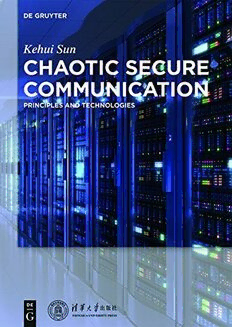
Chaotic Secure Communication: Principles and Technologies PDF
Preview Chaotic Secure Communication: Principles and Technologies
KehuiSun ChaoticSecureCommunication Also of interest CodingandCryptography Natas˘aZ˘ivic´,2013 ISBN978-3-486-75212-0,e-ISBN978-3-486-78126-7, Set-ISBN978-3-486-80581-9 ModernCommunicationsTechnology Natas˘aZ˘ivic´,2016 ISBN978-3-11-041337-3,e-ISBN978-3-11-041338-0, e-ISBN(EPUB)978-3-11-042390-7 ACourseinMathematicalCryptography G.Baumslag,B.Fine,M.Kreuzer,G.Rosenberger ISBN978-3-11-037276-2,e-ISBN978-3-11-037277-9, e-ISBN(EPUB)978-3-11-038616-5 ComputationalMethodsinAppliedMathematics CarstenCarstensen(Editor-in-Chief),4issuesperyear ISSN1609-4840,e-ISSN1609-9389 Kehui Sun Chaotic Secure Communication Principles and Technologies Thisworkisco-publishedbyTsinghuaUniversityPressandWalterdeGruyterGmbH. Author Prof.KehuiSun SchoolofPhysicsandElectronics CentralSouthUniversity Hunan,China ISBN978-3-11-042688-5 e-ISBN(PDF)978-3-11-043406-4 e-ISBN(EPUB)978-3-11-043326-5 Set-ISBN978-3-11-043407-1 LibraryofCongressCataloging-in-PublicationData ACIPcatalogrecordforthisbookhasbeenappliedforattheLibraryofCongress. BibliographicinformationpublishedbytheDeutscheNationalbibliothek TheDeutscheNationalbibliothekliststhispublicationintheDeutscheNationalbibliografie;detailed bibliographicdataareavailableontheInternetathttp://dnb.dnb.de. ©2016WalterdeGruyterGmbH,Berlin/Boston Coverimage:scanrail/iStock/thinkstock Typesetting:IntegraSoftwareServicesPvt.Ltd. Printingandbinding:CPIbooksGmbH,Leck (cid:2)8Printedonacid-freepaper PrintedinGermany www.degruyter.com Preface Since meteorologist Lorenz discovered chaotic phenomenon in 1963, it has been widelyanddeeplystudied.Chaostheoryisknownasthethirdscientifictheoretical revolutionfollowingthetheoryofrelativityandquantumtheoryinthe20thcentury. Especially,PecoraandCarrollreportedchaossynchronizationin1990,whicharoused anupsurgeofstudyonchaoticsecurecommunications.Aftermorethan20yearsof researchanddevelopment,chaoticsecurecommunicationtechnologyisbecominga newgrowthpointinthefieldofinformationtechnology.Ononehand,theapplication ofchaoswillcontinuetopromotepeople’sprofoundunderstandingofthenatureof chaos.Ontheotherhand,thenewproblemsintheapplicationofchaoswillfurther leadtothefurtherresearchofchaos.Althoughchaoticsecurecommunicationtechno- logystillhasalongwaytogo,theapplicationofchaosinsecurecommunicationfield showsusapromisingprospect. Thisbookincludesninechapters.Inthefirstchapter,thehistoryofchaosresearch isreviewed,andtheimportantcharactersandstoriesinthedevelopmentofchaosare introduced,andtheadvancesinresearchonchaoticsynchronizationcontroltechno- logyandchaoticsecurecommunicationmethodarereviewed.Inthesecondchapter, themainanalysismethodsofthechaoticcharacteristicofthenonlinearsystemare presented.Thetypicalchaoticdynamicsystemmodelsareintroducedbrieflyinthe third chapter. In the fourth chapter, the principle and technology of the synchron- ization control between chaotic systems are investigated. In the fifth chapter, the technologyandschemeofsecurecommunicationbasedonchaoticsynchronization arediscussed.Inthesixthchapter,thedataencryptiontechnologybasedonchaotic sequences is discussed. In the seventh chapter, the audio and video real-time en- cryptioncommunicationtechnologybasedonchaosisstudied.Intheeighthchapter, thelatestresearchprogress,dynamiccharacteristicanalysis,andsimulationmethods of fractional-order chaotic system are studied. In the ninth chapter, the design and implementationtechnologyofchaoticcircuitisstudied. Inordertofacilitatereaderstograsptheimportantknowledgepointsinthebook, theauthorlistsafewquestionsattheendofeachchapter.Inordertofacilitatethe searchofrelevantliteratureandtopublishtheresearchresultsontime,journalsabout chaosresearcharelistedasAppendixAofthisbook.Inaddition,inordertofacilit- atereaderstoquicklygraspthechaosofresearchmethods,theauthorcollectedthe relevantanalysisprogramsasshowninAppendixB. Basedontheresearchresultsinthefieldandalargenumberofrelatedliteratures, thisbookiswrittenthroughrepeatedmodification. Inthefieldofresearchofchaos,theauthorhasgottheguidanceandinspiration of many professors including Professor Sprott J C from the University of Wisconsin MadisonintheUnitedStates,ProfessorQiuSSfromSouthChinaUniversityofTech- nology,ProfessorYuSMfromGuangdongUniversityofTechnology,ProfessorWang VI Preface GYfromHangzhouUniversityofElectronicScienceandTechnology,ProfessorZhang TS,ProfessorShengLY,andProfessorZhuCXfromCentralSouthUniversity.Theau- thorexpressessinceregratitudetoalltheprofessors.Inaddition,inthepreparation ofthisbook,previousgraduatestudentsgavealotofsupport.TheyareMouJ,ZhouJ L,TanGQ,RenJ,ShangF,WangX,BaoSQ,YangJL,ChengW,LiuX,HeSB,Wang HH,WangY,ZuoT,AiXX,LiuWH,RuanJY,ZhangLM,XuYX,YuMY,YinYH. Thanksfortheircontributions! Iwouldsincerelyliketoappreciateandacknowledgethecommentsandsugges- tionsfromthereadersforthisbook. KehuiSun January2015,Changsha Contents 1 Introduction 1 1.1 Linear,Nonlinear,andChaos 1 1.2 DevelopmentofChaos 2 1.3 FamousScientistsandImportantEvents 4 1.3.1 LorenzandButterflyEffect 4 1.3.2 LiTien-YienandtheConceptofChaos 5 1.3.3 FeigenbaumandFeigenbaumConstant 6 1.3.4 LeonOngChuaandChua’sCircuit 7 1.3.5 GuanrongChenandChen’sAttractor 8 1.4 DefinitionandCharacteristicsofChaos 9 1.5 OverviewofChaosSynchronizationMethod 10 1.5.1 ChaosSynchronizationMethodsandCharacteristics 11 1.5.2 OtherSynchronizationMethodsandProblems 14 1.6 SummaryofChaosSecureCommunication 15 1.6.1 ChaoticAnalogCommunication 16 1.6.2 ChaoticDigitalCommunication 16 1.6.3 Encryption Communication based on Chaotic Sequence 17 1.7 ChaosResearchMethodsandMainResearchContents 18 Questions 20 2 CharacteristicAnalysisMethodsforNonlinearSystem 21 2.1 PhaseDiagramAnalysisMethod 21 2.2 PowerSpectralAnalysisMethod 22 2.3 PoincaréSectionMethod 24 2.4 LyapunovCharacteristicExponentMethod 25 2.4.1 DefinitionofLyapunovCharacteristicExponent 25 2.4.2 LyapunovExponentSpectrum 27 2.4.3 PhysicalMeaningofLyapunovExponent 27 2.4.4 ConditionLyapunovExponent 29 2.5 FractalDimensionAnalysisMethod 30 2.6 0–1TestMethod 30 2.6.1 0–1TestAlgorithm 30 2.6.2 Improved0–1TestAlgorithm 32 2.6.3 Applicationof0–1TestAlgorithm 33 2.7 DividingFrequencySamplingMethod 33 2.8 Pseudo-PhaseSpaceMethod 34 2.9 ComplexityMeasureAlgorithm 35 2.9.1 SpectralEntropyComplexityAlgorithm 36 2.9.2 C ComplexityAlgorithm 38 0 Questions 40 VIII Contents 3 TypicalChaoticSystems 41 3.1 Discrete-TimeChaoticMap 41 3.1.1 LogisticMap 41 3.1.2 TentMap 44 3.1.3 HénonMap 44 3.1.4 TangentDelay-EllipseReflectingCavitySystemMap 46 3.2 Continuous-TimeChaoticSystem 47 3.2.1 DuffingOscillator 48 3.2.2 vanderPolOscillator 49 3.2.3 LorenzSystem 49 3.2.4 RösslerSystem 50 3.2.5 Chua’sCircuit 51 3.2.6 ChenSystem 55 3.2.7 LüSystem 55 3.2.8 UnifiedChaoticSystem 57 3.2.9 SimplifiedLorenzSystem 59 3.2.10 StandardforaNewChaoticSystem 62 3.3 HyperchaoticSystem 62 3.3.1 RösslerHyperchaoticSystem 62 3.3.2 ChenHyperchaoticSystem 63 3.3.3 FoldedTowelHyperchaoticMap 64 Questions 65 4 ChaoticSynchronizationPrincipleandMethod 66 4.1 DefinitionofChaosSynchronization 66 4.2 PerformanceIndexofChaoticSynchronizationSystem 67 4.3 PrincipleandPerformanceofFeedbackControlSynchronization 69 4.3.1 Multivariabledrivefeedbacksynchronizationforchaotic system 69 4.3.2 LinearandNonlinearFeedbackSynchronizationfor DiscreteChaoticSystem 73 4.4 ParameterAdaptiveSynchronizationBasedonPecora–Carroll SynchronizationCriterion 84 4.4.1 PrincipleforAdaptiveSynchronization 84 4.4.2 ChooseControlLawandControlParameters 85 4.4.3 DeterminetheBoundaryandRangeoftheControl Constant 86 4.4.4 SimulationResultsandDiscussion 87 4.5 AdaptiveSynchronizationControlBasedonLyapunovStableTheory 88 4.5.1 Adaptive Synchronization Control with Certain Parameter 88 4.5.2 AdaptiveSynchronizationControlwithUncertain Parameters 91 Contents IX 4.6 IntermittentFeedbackSynchronizationControl 94 4.6.1 IntermittentSynchronizationControlbetweenDifferent Systems 94 4.6.2 Synchronization Simulation and Performance Analysis 97 4.7 SynchronizationControlBasedonStateObserverMethod 99 4.7.1 DesignPrincipleofStateObserver 99 4.7.2 Design of State Observer for Unified Chaotic System 101 4.7.3 SimulationandDiscussion 101 4.8 ChaosSynchronizationBasedonChaosObserver 104 4.8.1 DesignPrincipleofChaosObserver 104 4.8.2 ChaosObserveroftheUnifiedChaoticSystem 105 4.8.3 Synchronization Simulation and Performance Analysis 106 4.9 ProjectiveSynchronization 108 4.9.1 PrincipleandSimulationofProportionalProjection Synchronization 109 4.9.2 Principle and Simulation of Function Projective Synchronization 113 4.9.3 PrincipleandSimulationoftheAdaptiveFunction ProjectiveSynchronization 116 4.10 ProblemsandDevelopmentofChaosSynchronization 123 Questions 124 5 SecureCommunicationTechnology BasedonChaosSynchronization 125 5.1 ChaoticMaskingCommunication 125 5.2 ChaosShiftKeyingCommunication 130 5.2.1 COOKCommunication 131 5.2.2 CSKCommunication 132 5.2.3 DCSKCommunication 137 5.2.4 FM-DCSKCommunication 139 5.2.5 QCSKCommunication 140 5.3 ChaosParameterModulation 145 5.4 ChaoticSpreadSpectrumCommunication 148 5.4.1 PrincipleofChaoticDS/SSCommunication 148 5.4.2 GenerationofChaoticSpreadSpectrumCode 150 5.4.3 SimulationModuleDesignofMultiuserChaoticSpread SpectrumSystem 152 5.4.4 DesignandSimulationofMultiuserChaoticSpread SpectrumSystemBasedonRakeReceiver 158 X Contents 5.4.5 PerformanceAnalysisofMultiuserChaoticSpread SpectrumSystemBasedonRakeReceiver 159 Questions 163 6 DataEncryptionBasedonChaoticSequence 164 6.1 ChaosCryptography 164 6.1.1 TraditionalCryptography 164 6.1.2 RelationshipbetweenChaosCryptographyandTraditional Cryptography 166 6.1.3 PrincipleofChaosSequenceEncryption 167 6.2 DataEncryptionAlgorithmBasedonChaoticSequence 168 6.2.1 Basic Requirements of Chaotic Encryption Algorithm 168 6.2.2 LogisticMapandItsStatistics 170 6.2.3 ChaoticEncryptionModelandAlgorithm 170 6.2.4 ImplementofEncryptionAlgorithmBasedonChaotic Sequence 172 6.2.5 SystemPerformanceAnalysis 175 6.3 BinaryWatermarkImageEncryptionAlgorithmBasedonChaos 176 6.3.1 ImprovementofChaoticPseudo-RandomSequence Generator 178 6.3.2 BinaryWatermarkImageEncryptionAlgorithmBasedon TD-ERCSMap 178 6.3.3 PerformanceAnalysisofEncryptionAlgorithm 179 6.4 ColorImageWatermarkingAlgorithmBasedonChaoticMapandWavelet Transform 182 6.4.1 Wavelet Transformation Algorithm and Its Application 183 6.4.2 DesignandImplementationofWatermarkEmbeddingand ExtractionAlgorithm 186 6.4.3 SimulationandPerformanceAnalysis 190 6.5 ChaoticImageEncryptionAlgorithm 196 6.5.1 Chaos-BasedImageEncryptionTechnology 196 6.5.2 ANewChaoticImageEncryptionScheme 199 Questions 205 7 AudioandVideoChaoticEncryption andCommunicationTechnology 206 7.1 PrincipleofReal-TimeVoiceEncryptionCommunication 206 7.1.1 Principle of Digital Encryption Communication System 206 7.1.2 Real-Time Voice Encryption and Communication System 208
